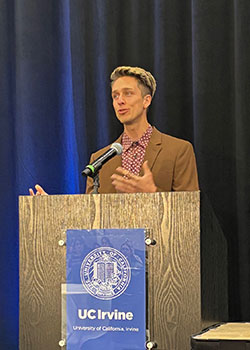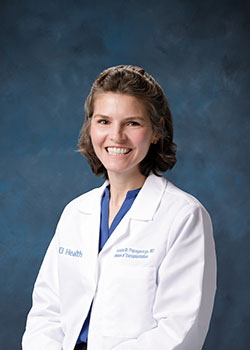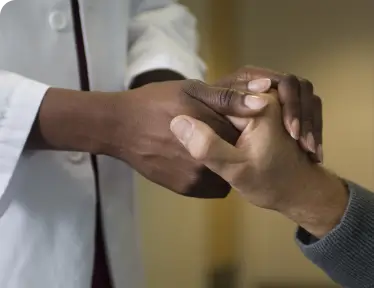A living organ donor's lasting impact

Clayton Moore is on a mission to demystify living-donor kidney transplants. In June, the 26-year-old gifted his kidney to a complete stranger and he couldn’t be happier about his decision.
The Tustin-based actor even posted a YouTube video of the entire kidney donation process. In the candid and frequently humorous recording, Moore serves up the details — before, during and after donation — including his why.
“When I was a kid, my Great Aunt Fern had kidney failure and she was on dialysis for several years,” Moore remembers. “During this time, her memory became impaired. She wasn't able to travel. She wasn't able to really enjoy her life.”
But when she received a kidney from a deceased donor, “it was like all the lights came back on!” She fully enjoyed her life for another decade until her death at age 90.
That memory prompted Moore to reach out to the UCI Health Living Donor Program.
“The idea that I could give someone else's Aunt Fern a chance at that, that inspired me to donate!”
Living donation is the gold standard

More than 90,000 people in the United States are waiting for a lifesaving kidney transplant, according to the National Kidney Foundation. Because the number of people needing a kidney vastly exceeds the number of deceased-donor organs available, the average wait time for a transplant is three to five years, with 12 people dying every day as they wait.
The UCI Health Kidney Transplant Program has been a vital resource for patients suffering from chronic kidney disease for more than 40 years.
As part of Orange County’s only academic health system, it is the largest and fastest-growing program in the region, offering the latest transplant technologies along with life-changing research and clinical trials.
The transplant team’s Living Donor Program has also been growing, with living-donor kidneys making up 16% of the 221 transplants performed last year at UCI Health.
Living-donor kidney transplant is the gold standard for end-stage renal disease, says UCI Health transplant surgeon Dr. Christina Papageorge, who removed Moore’s kidney for transplantation.
“They offer better long-term outcomes, faster recovery and no wait times,” she says. “A living-donor kidney, on average, will last twice as long as one received from a deceased donor.”
What’s it like to donate?
“For a living donor, our primary goal is to make sure that we are not exposing them to undue risk with donation and that they're still going to be able to live a full, normal, healthy life with one kidney,” says Papageorge.
Excellent health is the first requirement. Potential donors undergo a comprehensive evaluation that includes a thorough medical history and physical exam, lab tests, urine studies, cardiac testing and imaging studies, including scans and ultrasound imaging of their kidneys.
“We also coordinate meetings with a nutritionist and an independent social worker who can advocate for their best interests,” Papageorge says.
“The UCI Health transplant team was friendly and thorough, and I felt supported the whole way,” adds Moore. “They're not going to let you donate unless you know exactly what's going on. And if you have questions, they're forthright with the answers.”
Paired donation

Altruistic donors like Moore are a rarity. Most patients who receive a living-donor transplant enlist the help of loved ones and friends to find a compatible donor.
“While we wish we could give a living donor transplant to every patient with kidney failure, the reality of the situation is that they will need to find their own donor,” says Papageorge.
But the transplant team can provide guidance and support, if desired. They are able to coach patients on how to talk to loved ones about donation. That may include sample scripts, role-playing exercises and social network mapping advice.
Willing donors still must undergo tests to determine whether they are a match for the person in need of a kidney. That’s where paired donations through national organ donation programs come in.
“If you know someone who needs a kidney and you don’t end up being a match, you can still donate on their behalf,” Papageorge says. “Through a paired donation, your kidney can be matched with a different person. Then a matched kidney will be found for your person.”
Patient and donor support
Living donors have access to extensive support services, says Papageorge. The recipient's insurance will cover the cost of pre-donation testing and the surgery itself.
During their recovery period, donors may receive lost-wage reimbursement and coverage for dependent care through the National Kidney Registry’s Donor Shield program. In addition, the National Living Donor Assistance Center (NLDAC) can provide financial aid for childcare costs.
“Should they ever need a kidney in the future, donors also have priority transplant access,” she adds.
Minimally invasive surgery, faster recovery
Once testing is complete and a match is found, the donor and recipient agree on a surgery date. Surgery for both the living donor and the recipient takes about three to four hours.
“The big difference for donors is that we perform the surgery using minimally invasive techniques,” says Papageorge. “The main incision to remove the kidney is about two to three inches. I also make three tiny incisions for the camera and robotic instruments.”
This means recovery is much faster than it was 10 or 20 years ago "with most patients staying in the hospital one or two days and recovering within two weeks," Papageorge says.
Moore says he was home less than 24 hours after surgery.
For the kidney recipient, the donated kidney works right away and they also have a smoother recovery. The greatest benefit, however, is that they didn’t have to wait for a deceased-donor kidney to become available, which often takes up to 10 years in this region of the United States.
“We currently have 700 people waiting for a kidney transplant right now at UCI Health,” says Papageorge. “There is always a great need for living kidney donors.”
A return to normal
 At three months post-donation, Moore is completely recovered and savoring life with his wife, Hannah.
At three months post-donation, Moore is completely recovered and savoring life with his wife, Hannah.
I actually felt pretty good at two weeks,” he says. “But by three weeks after surgery, I was back to all my day-to-day activities other than lifting heavy objects and running.
He now drinks much more water throughout the day, which is a standard recommendation to keep kidneys functioning well.
He’ll need to return for lab tests in December, with additional follow-ups a year and two years after surgery to ensure his remaining kidney stays in top shape.
“I also try to eat healthier meals and watch my sodium intake because too much isn’t good for your kidneys.”
Moore continues his energic performances with The Imagination Machine, a local theater company that travels throughout Orange County to bring student stories to life on stage.
A lifesaving gift
“I really think it's the best time in human history to donate a kidney,” he says. “It wasn't a breeze, but in terms of difficult things I've done in my life, donating a kidney is not even in the top 10.”
Papageorge says a living-donor donor kidney is by far the best treatment someone with kidney failure can get, offering so many major advantages over waiting for a deceased donor kidney, “It truly is a life-altering and lifesaving gift.”
Moore hopes more people will consider becoming a living donor.
“I think donation doesn't occur to people because it's just not that common. But I really want to encourage others to give it some consideration because it can make a significant and lasting impact on someone’s life."
To learn more about becoming a kidney donor, call the UCI Health Living Donor Program at 714-456-8441.
Related stories




